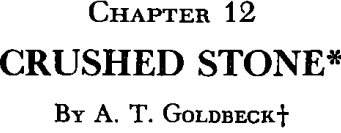Table of Contents
The use of stone as a building material in relatively large blocks is recorded in ancient historical records but only within the past 200 years has broken stone in small sizes begun to have extensive use, principally in highway-construction. Tresaguet, in 1764, describing his method for highway construction in France, required the top surface to be built of stone about the size of a walnut, broken by the use of a hammer. It is said that the Romans, in the top layer of their rather massive roads, used large stones bonded together with lime mortar and bedded in small stones mixed with mortar. Much of the early macadam as built by McAdam around 1815 in England was made with hand-sledged broken stone.
Sources and Classification
Crushed stone is produced from all three groups of rocks on the earth’s surface—igneous, sedimentary, and metamorphic. It has been estimated that the lithosphere, the solid portion of the earth’s crust, is composed of: igneous rocks, 95 pct; shale, 4 pct; sandstone, 0.75 pct; limestone, 0.25 pct. However, these percentages by no means represent the percentages of crushed stone produced of the several types of rock. The igneous rocks have solidified from a molten state, either at the earth’s surface or at various depths; sedimentary rocks have been formed either through the consolidation of the products of former rock disintegration—for illustration, sandstone,—or they have been formed from an accumulation of organic remains, chiefly of a calcareous nature, as typified by limestone and dolomite; metamorphic rocks have been produced by the action of physical and chemical forces such as heat, pressure and moisture on both the sedimentary and the igneous rocks. Thus, gneisses and schists are the metamorphosed form of granite, while marble has resulted from the alteration of sedimentary rocks such as limestone.
Economic availability and commercial usefulness control the quantities of the respective rock types produced, so notwithstanding the relatively small percentage of limestone available on the earth’s surface, limestone has by far the greatest production of any of the rocks. The igneous rocks found in southern New England, New York, New Jersey, and Pennsylvania are relatively small outcrops, but they furnish a large tonnage of the production of this type of material, which is found also in the Appalachian and the Pacific Coast states.
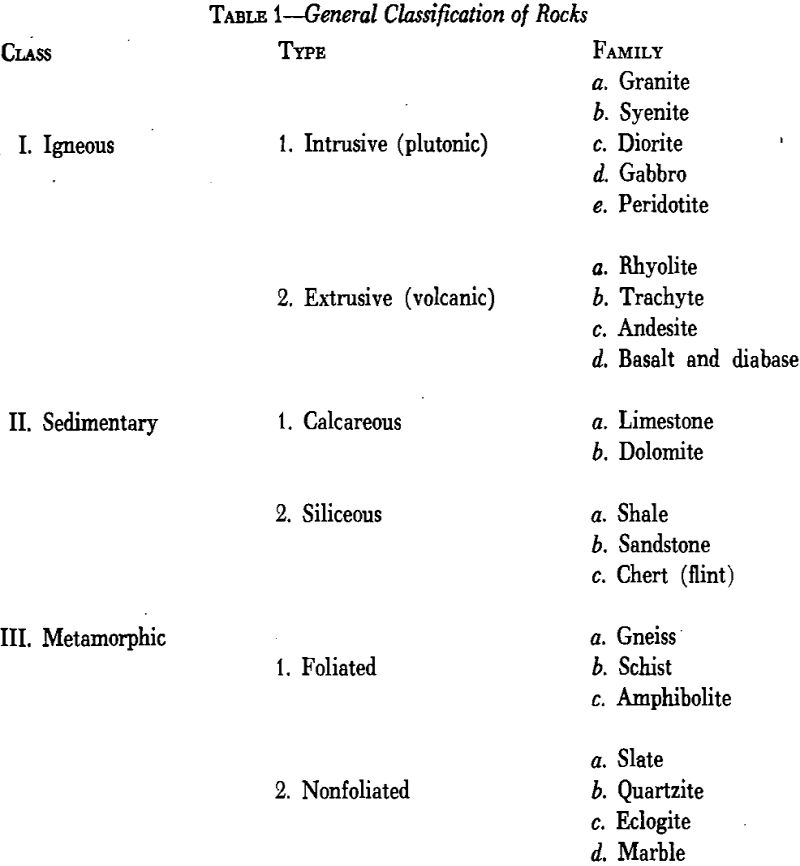
Unconsolidated products of former rock types may form sands, gravels, silts, and clays. This unconsolidated material may pass through the process of induration into consolidated masses; clay may become shale; shale in turn may become slate. Sandstones resulting from the consolidation of sand and the cementation of the sand grains are either calcareous, ferruginous, argillaceous, or siliceous, depending on their cementing materials. They form an important class of rocks, used in the past very largely as building stone. Such material is given common names by the trade, such as flagstone, brownstone, bluestone, graystone.
Mineral Composition of Rocks
No doubt the mineral composition as well as the structure of rocks plays an important part in controlling their suitability for different structural work and it is the combination of these important factors that makes certain rocks especially useful for particular purposes. Trap rock is highly regarded for uses in which high resistance to impact and loads is important, as in railroad ballast, and at the same time resistance to the disintegrating action of the weather. The high calcium carbonate content of limestones makes them particularly important for chemical and metallurgical purposes and for the treatment of soil for agricultural purposes.
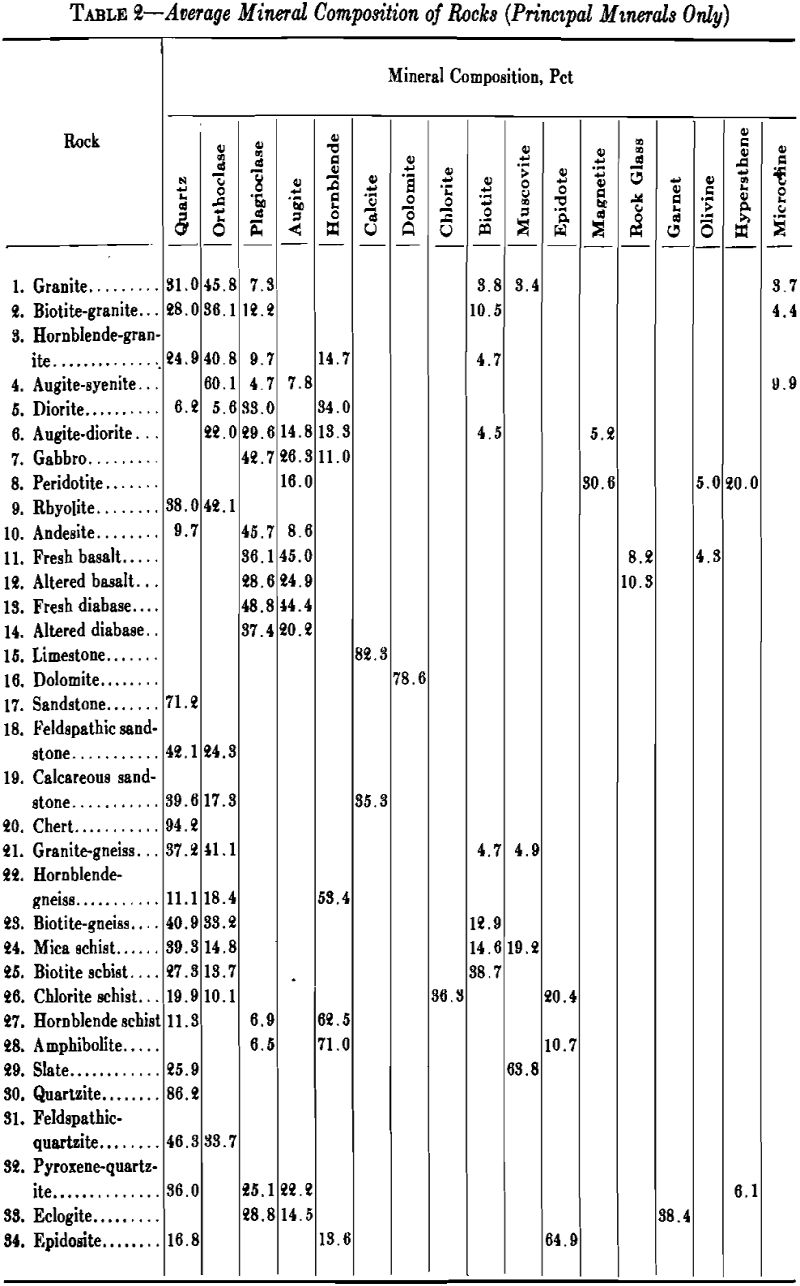
The crushing-strength test is not practiced as a rule except on stone intended for building purposes. The fact is that most rocks have adequate compressive resistance for structural purposes. Crushed stone does not lend itself to the compression test very readily unless the sample is taken from the ledge rock before it is crushed. Generally the specimen consists of a 2-in. core 2 in. high. The ends must be carefully finished to a flat surface and the bearing blocks must be ground to as flat a surface as possible. No capping material should be used on the ends of the specimen during the test. Pressure is expressed in terms of pounds per square inch of ultimate load.
The specific gravity of rock is the term used to express the relationship between the weight of the rock and the weight of an equal volume of water. The ASTM has recognized different kinds of specific gravity as applied to aggregates, the principal of which are bulk specific gravity and apparent specific gravity. Bulk specific gravity is the ratio of the weight in air of a given volume of a permeable material, including both its permeable and impermeable voids, in relation to the weight of an equal volume of distilled water. The volume of rock in this case is the volume that would be enclosed by an impermeable membrane of zero thickness stretched around the surface of the rock. Apparent specific gravity is the ratio of the weight in air of a given volume of the impermeable portion of a permeable material —that is, the solid rock including its impermeable voids or pores—in relation to the weight in air of the same volume of distilled water. The volume of rock considered in this case is the same as in the case of bulk specific gravity minus the volume of the permeable voids.
Soundness of Rock
By “soundness of rock” is meant its resistance to the weather, generally its resistance to freezing and thawing action. The rapidity of disintegration of rock under the action of freezing and thawing depends upon a number of factors, the principal of which is the extent to which the pores in the rock are saturated with water. If it were possible to thoroughly fill the interior voids in rock, disintegration would occur in a very few cycles of freezing and thawing because of the tremendous internal force exerted by the ice formed in the pores of the rock. On the other hand, if there is not complete saturation, the action is by no means so severe, because incomplete filling of the voids leaves a space to be occupied by the ice, which then has less disruptive effect. High absorption accompanied by weakness of structure accelerates the disrupting effect of freezing. Apparently the size and shape of the pore structure influence the severity of disruption due to freezing.
In the laboratory, attempts are made to accelerate the action of freezing and thawing by the use of special tests for soundness of the rock. The tests now in general practice are the so-called sodium sulphate and the magnesium sulphate accelerated soundness tests. These tests are fully described in the Standards of the ASTM. Briefly, the sodium sulphate solution is prepared as a saturated solution at 70°F. The previously prepared rock samples are washed, dried, and then immersed in the solution and kept there at a constant temperature for approximately 18 hr. The sample is then removed, dried in an oven at 105° to 110°C, then cooled to room temperature. T
Many laboratories also make freezing and thawing tests but the freezing test has not yet been standardized and is performed differently by different laboratories. There seems to be no agreement as to the procedure to be used, whether the sample is to be immersed in water during freezing or is to be thawed in the air or in water at room temperature, or in water at 40°F. A truly indicative accelerated soundness test is much to be desired.
Standard Sizes of Crushed Stone
Some 20 years ago, specifications for the size of stone for different purposes were written, some in terms of round-opening screens and others in terms of square openings. The sizes required for identically the same purpose varied largely, not only as between maximum and minimum sizes but also in the limits of tolerance permitted on the intermediate screens. In consequence of this wide range of specifications, commercial stone companies were required to stock more sizes than were needed to really meet construction requirements. So an effort was made, initiated largely by the three national aggregate associations, to bring about a simplification and standardization of aggregate sizes throughout the United States. The aid of the Division of Simplified Practice of the National Bureau of Standards was sought and as a consequence there has been evolved a Simplified Practice Recommendation for sizes, which at the present time is designated as R 163-48. It is not expected that this standard will remain constant but that it will be improved as the need becomes apparent. Many of the state highway departments have accepted this standard either in whole or in part and most of the national specifications are now written in terms of this recommendation. Its complete adoption by all local specification-writing bodies would do much toward simplifying the production of crushed stone and would eliminate difficulties in its use.
Uses for Crushed Stone
Crushed stone for the most part is used as an aggregate in highway construction, concrete, railroad ballast, as riprap, in sewage filter beds, as fine aggregate in concrete products and for many other purposes. Limestone and marble are used largely as fluxstone in smelting, in the manufacture of cement, for lime, in sugar manufacture, in rock wool, for agricultural limestone, in the chemical industries and glass
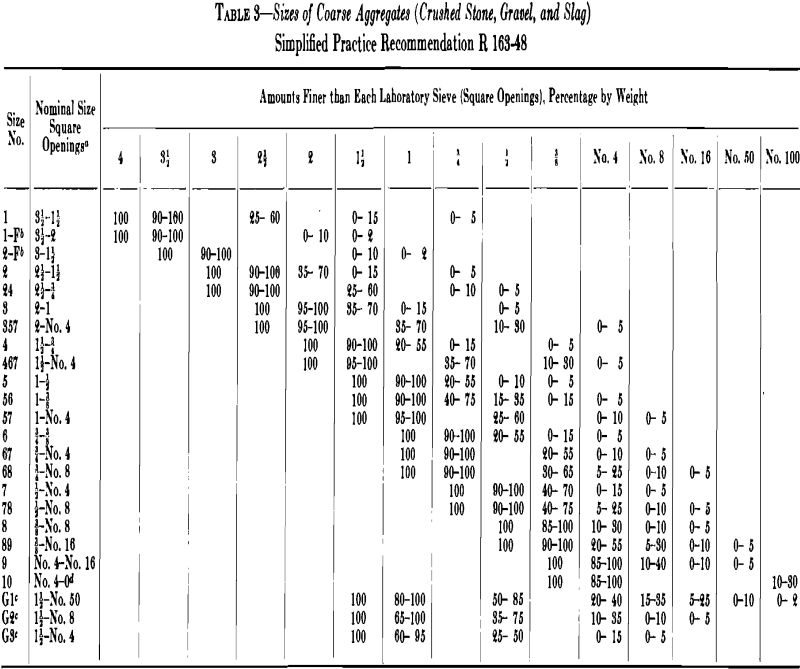
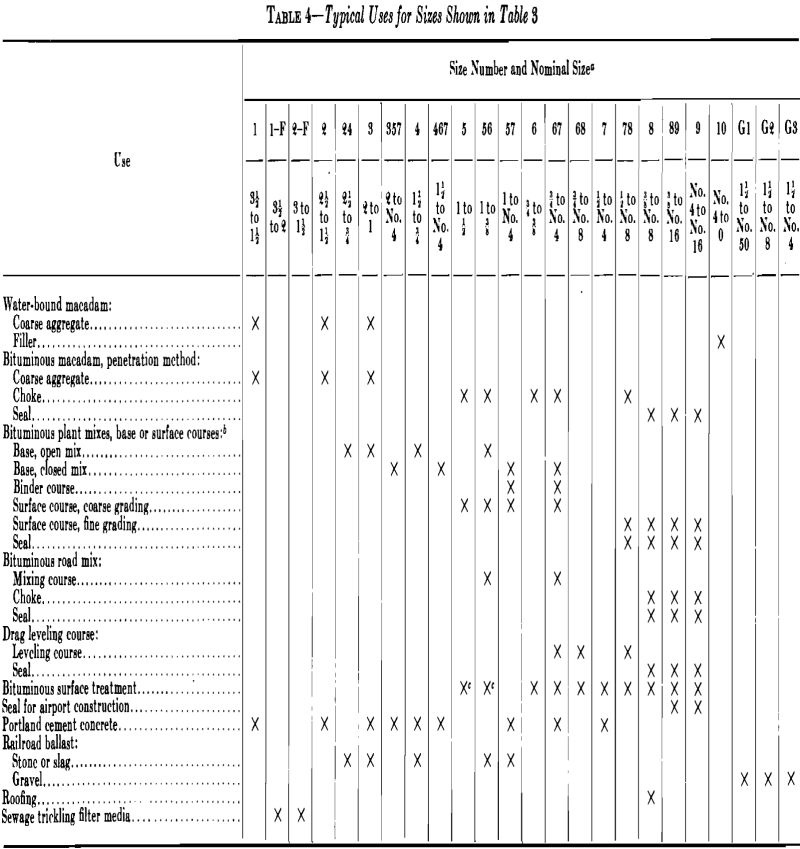
Concrete and Road Metal
Rocks of many different kinds, provided they are sufficiently strong and durable, are used in highway construction in various ways. Crushed stone is used as the coarse aggregate and frequently as the fine aggregate in concrete for pavements. It is used as the road metal for macadam bases and in the so-called traffic-bound type of base, as an aggregate in bituminous macadam, bituminous concrete and bituminous mixtures of the road-mix type, and as cover stone for bituminous surfaced roads, usually, in that case, in the form of small-sized material extending from approximately ½ in. to the No. 8 sieve size or smaller.
Stone Sand
The fine material resulting from the crushing operation is processed in many plants to produce a fine aggregate for use in concrete and in bituminous mixtures. Excessive 100-mesh dust is removed, generally by some form of washing process, and the fines are regraded to form a satisfactory sand gradation. All stone screenings are not equally suitable for making stone sand, because of their particle shape. Some screenings, because of their method of preparation and the characteristics of the material, contain many flat and extremely elongated pieces, and sand made from such material is apt to produce harsh working concrete. When the percentage of silica is low, as in many limestones and dolomites, an impact type of crusher is used for the preparation of stone sand. Rod mills and ring rolls and also the roll type of crusher are used for producing stone sand of very satisfactory particle shape. In general, it is undesirable to have the maximum size of stone sand greater than that which will pass a No. 8 sieve. Likewise, for the sake of workability, it is well to have at least 15 pct of the particles passing a No. 50 sieve with as high as 8 to 10 pct through a No. 100 sieve. Above all, the sand should be sound. The use of air-entraining agents in concrete has done much toward improving the quality of stone-sand concrete. Stone sands that formerly were somewhat harsh-working can be used with great satisfaction when an air-entraining agent is utilized in the concrete and the durability of the concrete is greatly improved.
Chemical Industries
In the chapter on Lime many uses for lime in the chemical industry are listed. The raw limestone is the basic product from which the lime is manufactured. The finer sizes of limestone are used for the neutralization of acid wastes; sometimes it is pulverized and sometimes it is used in the form of fines from the No. 8 to the No. 4 sieves, without dust, so as to provide free percolation for the acid solution to be neutralized.
Glass
Limestone is an essential ingredient in the manufacture of glass of different kinds, including flint, plate, window and bottle glass. High-calcium limestone is required. Relative freedom from iron is essential; for most glass, the iron content should not exceed 0.3 pct and for flint glass it should be not over 0.03 pct. Organic matter likewise is limited to about 0.3 pct. The size required is usually from 20 to 100-mesh, so as to permit its intimate mixture with silica of about the same gradation.
Stripping
There are very few areas that are not covered with some overburden, which must be stripped from the surface before quarrying can be done. At a few places where the overburden is shallow and consists of friable soil, the stone is shot down together with the overburden, which is then removed by a washing process.
Hand stripping of overburden is seldom practiced today, in view of the high cost of labor and the development of extremely efficient earth-handling equipment.
Transportation—Tractors with trailers are suitable for the shorter hauls of wastes to the dump, trucks for the short and intermediate hauls, locomotives with cars for the intermediate and long hauls. For conditions of deep overburden and long haul, locomotives with contractor-type side-dump cars give the lowest costs as a general rule. Diesel power is fast replacing steam locomotives for this purpose. If dragline equipment is used, the number of track changes at the stripping site is about one half that required for shovel equipment, for the dragline has a reach of about twice that of its equivalent in the dipper type of shovel. Track shifting machines are obtainable in standard and narrow gauge for use on the dump. When trucks are used, it is well to provide a tractor with scraper, or bulldozer, for trimming the dump and maintaining the road.
Quarrying
Quarries are of two different types, the pit quarry and the bank quarry. The pit quarry is one in which the stone is extracted from below the general level of the surrounding country, and, as a rule, the stone is elevated to the crushing and treatment plant on the surface. Some operations in limestone and granite are of this type. The bank quarry is one in which the stone is taken mostly from above the level of the adjacent country. The rock is shot down to about the level of the crusher and no hoisting is required. Quarries of this type are generally self-draining and as a rule have no pumping problems.
In flat-bedded deposits, the quarry layout can generally be made to suit the plant location, highways, railroads, or other topographical features. The layout is more involved, however, where the strata are pitching and narrow. The hoist or point of attack should preferably be at the midpoint, along the strike, to reduce the average haul. The quarry face should be across the strata, at right angles to the strike for better breakage in blasting. Blasting a face lengthwise of the strata will cause a slippage on the bedding planes, create an overhang on one side and heavy-toe on the other. The slope of the bench should be upward at about 0.5 to 1.0 pct, to drain water from the loading place and back to a central sump. Also, this slope tends to equalize the hauling efforts by favoring the loads.
In the softer rocks associated with open or clay-filled seams, too much explosive at one point will tend to pulverize the stone adjacent to the drill hole and the shattering force will be cushioned by the clay or air space, leaving many large blocks unbroken. The larger holes with wider spacing are more applicable to the hard, dense rocks, such as trap.
Detachable bits are now in common use. They effect a saving in underground mining where the handling of drill steel between sharpening shop and the working face is always a problem and an expense. They are particularly well suited to the small quarry, where getting forged bits properly dressed and tempered may be difficult. There is also less investment in steel than when carrying the larger quantity of different lengths necessary with forged bits.
“Powder costs on the primary shooting can be arrived at from this table fairly closely. There is, in the next to the last column, tons per pound of powder used by primary shots. These vary from 2.6 tons per pound to 7.5, which is quite a variation. The 2.6 on a dolomite was for a 6-in. hole; the 7.5 is a diorite rock with 6§-in. hole. The 9-in. holes, on the use of powder per ton of stone broken down, seem to be reasonably consistent, around 5 to 6 tons per pound. That, I believe, just glancing at the table, is a better yield of stone than the smaller diameter holes which look as though they would average somewhere around 4. When you compare the large-diameter hole for overall results, there are other factors, of course, than the dynamite costs. You will immediately bring in the question of what breakage will occur, whether that breakage is better or poorer. Our own experience is that a little more money spent on primary drilling can quite often yield a great saving on the floor of the quarry in shovel capacity.”
“Upper” and “blanket” shooting are terms applied to making a blast before the preceding one is entirely cleaned up. A bank of loose stone prevents scattering of the rock out of the quarry floor and confines it to afford better loading conditions for the shovel, reduces the labor of cleaning up the floor, and reduces trackwork where this type of hauling is used. Better fragmentation may result, although this is questionable.
Black powder, nitrostarch, and liquid oxygen explosive (LOX) are also used in the quarrying industry; to a lesser extent, however, than the previously mentioned explosives.
During the primary blast, insufficient fragmentation may result in the formation of blocks of stone that are too large to be handled by the primary crusher. These must be broken down by some means, in order to be usable. The use of mud capping and of jackhammer drilling and blasting is very common, but jackhammer drilling has long been regarded as an undesirable type of work in the quarry and in recent years an old method of rock breaking has been revived; namely, the use of the drop ball. Highly mobile, single-operated crawler cranes are used for hoisting and dropping a heavy steel “ball” weighing about 7000 lb. Generally a 1½-yd crane, equipped with a 60-ft boom, has been found suitable. Such a rig will break a 30-ton rock of almost any toughness. It can also be used for knocking down dangerously high piles of stone and in scaling loose pieces from the quarry face. It has been reported that a drop ball manipulated by one crane can do the work of 6 to 10 men operating jackhammers. Its use is spreading very rapidly. There has been experimentation on the shape and weight of the ball, on replaceable striking faces, on the kind of hitch to be used in fastening the hoisting cable to the ball, and on the method of operation. A steel billet of hexagonal cross section makes a suitable weight or “ball.” These matters are discussed in some of the literature on the subject. Much of it is covered by the reports of the operating men’s sessions of the National Crushed Stone Association for the years 1946 and 1947.
Loading
Hand loading is rare but is still done where careful selection of the stone is necessary or in small operations at some distance from well- equipped plants. Naturally the cost of explosives becomes high in a hand-loading operation because of the necessity for blasting the stone to sizes small enough to be handled.
Power shovels are virtually indispensable in the average quarry, and even the smaller quarries use them because of the difficulty of securing hand-loaders. Shovels are now made with dippers of capacities from 3/8 to 32 cu yd. The larger sizes are built more for stripping operation where overcasting is possible and a long reach is desirable. A shovel with capacity as great as that of the transportation system would seem adequate but too small a shovel is uneconomical, even though its capacity may be as high as the plant is designed for. The uneconomical feature of smaller shovels is their inability to handle the larger pieces of rock left in the primary blast.
Haulage
Although haulage from the loading point to the crusher was carried on formerly in large quarries by the use of either standard-gauge or narrow-gauge railroads, and is still so carried on, nonetheless there is a decided trend in the ordinary quarry toward the use of motor-truck haul. The motor units used are either truck or tractor-trailer units. Most of the newer trucks are diesel-powered because of the greater fuel economy. No doubt each quarry must be studied individually to determine the best type of motor unit for its particular condition. In one large plant, light tractor hauling units are used, either Ford or Chevrolet, handling trailers of 12 to 24 tons capacity. Such light tractors handle these heavy loads on relatively level grades and are drawn up heavy grades by the use of a powered cable, to the end of which is attached a Barney car, which returns the cable to the bottom of the grade for the next load. This system has been used successfully in a number of quarries. It is believed, however, that the haulage units are gradually becoming larger, so that one driver may handle more tonnage. These larger units are more rugged and lose less time for repairs.
Crushing
Primary Crushing
Jaw crushers of the Blake type and the gyratory crusher are used for primary breaking. Roll jaw crushers (single roll and baffle plate) and hammer mills are sometimes used as primary crushers where the rock is of the soft and friable type. Other heavy-impact crushers have been used successfully, particularly in the softer type of stone. Crushers with frames of welded steel plate are gradually supplanting those of cast iron and cast steel, with consequent lower weight and greater strength. At least one manufacturer has used the electric-welded type of fabrication on the gyratory crusher.
For the harder rocks, the reduction in the primary crusher should be less than 6 to 1. Greater reduction than this tends to move the stone upward against the fixed jaw or concave and will greatly increase the stresses in the machine. With certain types of rock that tend to break in a slabby shape, some pieces of the product may be several times the size of the discharge opening in one direction. The use of corrugated jaw plates in the jaw crusher tends to reduce the slabby pieces and the gyratory crusher is said to give a product more cubical in shape because of the curved crushing faces.
Secondary Crushing
The demand for more and more fine stone for use in highway maintenance work and for other purposes has been growing. In many plants the bulk of the production must be less than one inch in size. This trend has some effect on the type of secondary crushers used, and cone crushers and high-speed flat-angle gyratories are very popular in the larger plants for the production of increasing quantities of smaller sizes. For the less abrasive types of rock, hammer mills and other impact types also are used. Special impact crushers of the squirrel-cage type have been used to reduce the quantity of soft pieces and at the same time to improve the shape of particle, thus permitting the stone to qualify under the highway specifications for abrasion loss.
Fine Crushing and Pulverizing
For fine crushing, many different types of machines are used, many employing the gyratory principle but having variations in the shape of the crushing surfaces. In the gyratory crusher, as the space between the crushing surfaces becomes smaller as the material passes through the crusher, the circumference must become larger to provide sufficient space to prevent blocking of the stone in its natural flow. This principle has led to the design of bellheads, spherical heads and flattened cones. Double-roll crushers having large capacity and relatively low headroom are used for fine reduction, and even for the production of stone sand.
Screening
Revolving and trommel screens, which were so universally used in crushed-stone plants some years ago, have been almost entirely superseded by vibrating screens, although they are still used to some extent as scalping screens for larger sizes, preliminary to crushing and screening operations, or as an integral part of revolving scrubbers. They do not serve well for screen sizes of less than ½-in., particularly when the material is damp. It is preferable to have the holes in the barrel not smaller than 1 in., obtaining the required smaller sizes through jackets. The vibrating screen, which was used originally for very fine screening, is now used for all sizes, even in one instance for the production of riprap.
Production of Stone Sand
Stone sand for use as a fine aggregate in concrete seems to be gaining in favor. Almost invariably when stone is the coarse aggregate for use in large dams, the fines are utilized for the production of stone-sand fine aggregate. It seems to be desirable that there be a minimum of flat and elongated pieces in stone sand and where the stone is not abrasive, hammer mills or other impact types of crushers are used very successfully. One very successful type of crusher for use in production of stone sand is the rod mill, using wet-grinding methods and employing a feed of not over one inch in size. In many cases the screenings resulting from the primary crusher are purposely omitted from the stone sand because of the possibility that they may retain more dirt than the secondary screenings, and also because they are more likely to be slivery in shape. Sometimes the sand is made up of screenings resulting from the gyratory or cone type of secondary crusher, from rod mills and rolls, all combined. Excessive dust passing through the 100-mesh sieve is removed sometimes by the dry process but more commonly by the wet process. Various types of classifiers are employed, depending in general upon separation of particle sizes by the carrying capacity of water flowing at different velocities. Different ideas among engineers have developed with regard to what constitutes a desirable gradation for stone sand. The following is given as an example of what would seem to be an excellent gradation, though one not easily produced:

